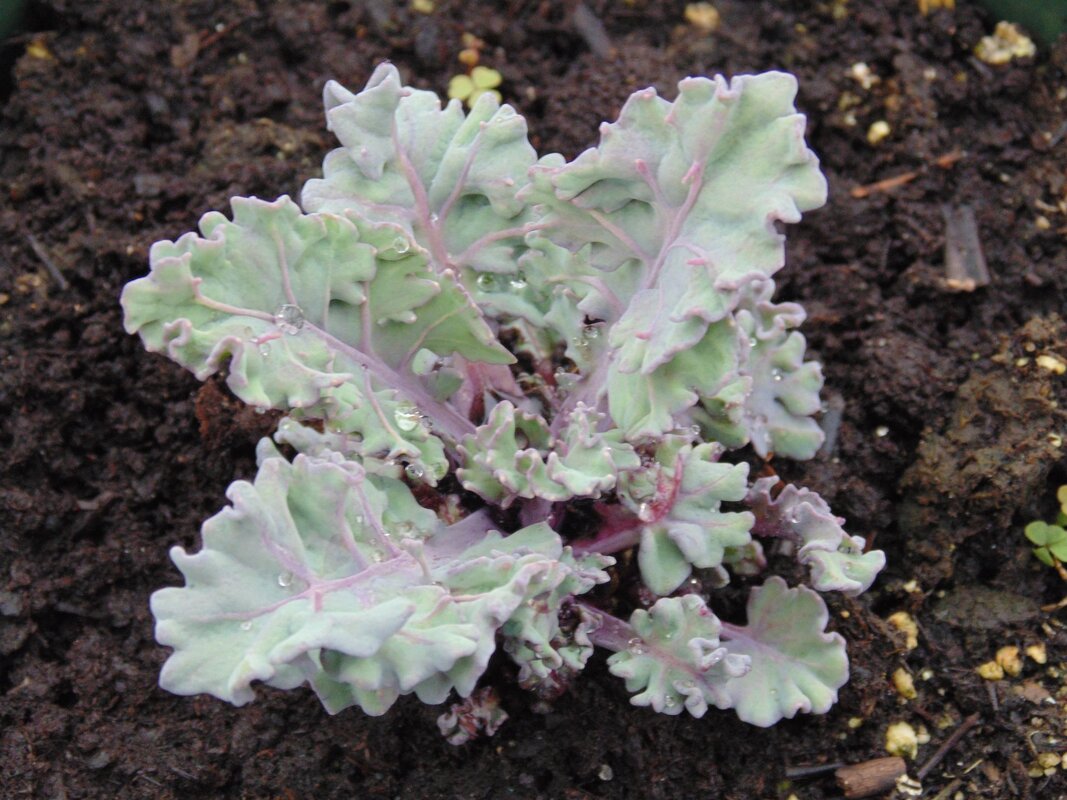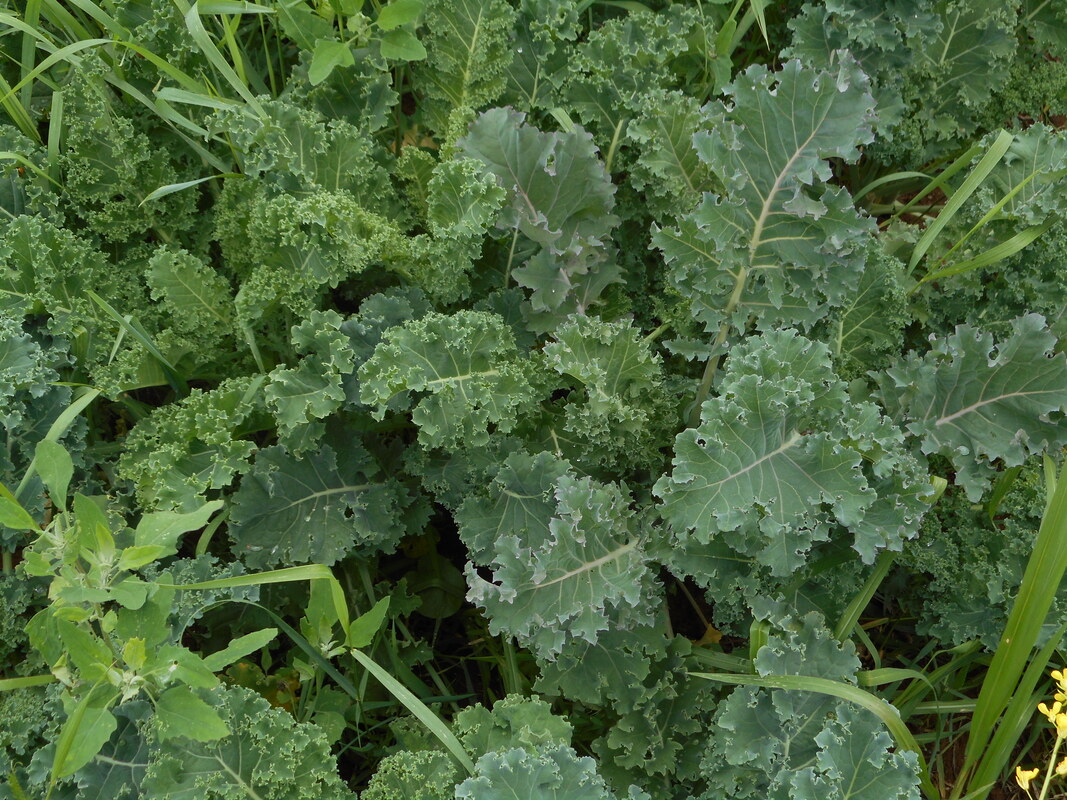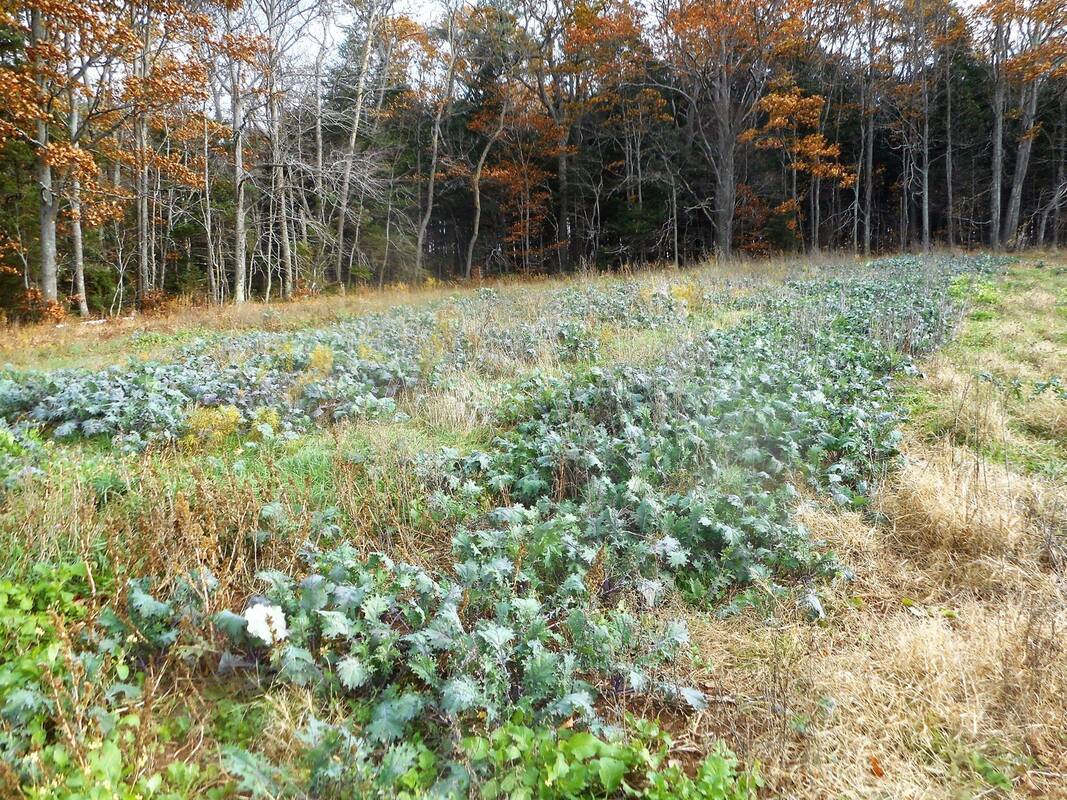|
Kale is an incredible vegetable. In our climate of Nova Scotia, a lot of plants grown for food cower in the face of cold weather, but not kale - it faces the cold head on. By moving sugars through it's stem and leaves it can freeze completely solid, then thaw and keep growing like nothing happened. There's not many plants that can provide us with food at almost any time of year and kale does, you can keep removing leaves from the sides and the top will keep on going. They are an immensely valuable food not simply for their rugged durability in the elements, but also for their superb nutritional content. It's called a superfood, and for good reason - it is one of the most nutrient dense foods on the planet. A single cup of kale contains over 100% of your daily recommended amount of Vitamin A, K and C and also contains Vitamin B6, Manganese, Calcium, Copper, Potassium and Magnesium - lots of good stuff to keep your body healthy! Some of our favorite ways of eating it are Kale Chips(crispy kale with olive oil) and Boerenkool(kale mashed with potatoes) - it is also great cooked with eggs and bacon, or in soup, stir-fry, smoothies or salad. Kale is often the brunt of a lot of jokes, people call it a fad, or that it's gross, or that people buy it just to let it rot in their vegetable drawer. But it's so much more than that! I urge anyone who thinks they don't like it to go down to a farmers market, buy some fresh picked kale and make Boerenkool... it's hearty and satisfying and is something that anyone would like and probably have cravings for afterwards (I sure do!). If you don't know what to do with it, just experiment - chop it up and throw it in with whatever you're making, you may surprise yourself. And for it being a fad... well it has a vast history of use over quite a lot of the world. There's several different but related species that people call kale: the most common one is Brassica oleracea. This species is quite amazing because it was originally just one thing "Wild Cabbage" but over thousands of years different groups of people from Asia to Europe selectively bred certain traits of the species to become more prominent and this led to Broccoli, Cauliflour, Cabbage, Brussels Sprouts, Kohlrabi, Collards, Kai-Lan and Kale. All from wild cabbage... pretty amazing stuff. This is green curly kale which is the most recognizable, great for kale chips and soup because the leaf is thicker. The variety name is "Westlander". There is also many curly kales that have been bred for their purple colour, some are green with purple tinges and some are totally purple. Fun fact: most kales change colour in cooler weather, their colours get a lot richer, some go from light green to dark green and some from green to purple. This kale's variety name is "Redbor" Another member of Brassica oleracea is Tuscan Kale, which also goes by Lacinato, Dinosaur or simply Flat Kale. This type has a bluer colour and is a little more tender than the curly kales with a slightly sweeter flavour. This type was bred over years and years in Tuscany, Italy so is not quite as cold hardy as other kale since it comes from a warmer climate. This kale's variety name is "Dazzling Blue" The second most popular species of kale is Brassica napus, which like B. oleracea has been selectrively bred from it's wild form for several different uses: Canola, Rutabaga and Siberian Kales are all the same species. Interesting enough, the species B. napus was originally formed (way back in prehistoric times) by B. oleracea hybridizing with another related Brassica species - B. rapa which includes turnips and napa cabbage! It's quite amazing how so many of the vegetables we eat have similar origins and stories, and how all the back-breaking work of previous generations have resulted in us having so much choice in modern times. Our ancestors just grew what they wanted to eat and what made them happy and healthy and we benefit from that process, and continue it in the future! This kale's variety name is "Red Russian", and it's from, you guessed it - Russia. It is definitely one of the most cold-tolerant kales owing from it's origins, and is very tender and tasty, our favourite on the farm. This kale is so vigorous that it will "go wild" if you let it flower and spread it's seeds, as you can see from the picture below it has taken over a corner of our field on it's own! And here is it a little closer to show the nice colour of the midrib. There's a lot of variation in B. napus kale.. Some are very ragged/shredded looking and some are more flat leafed as you can see in the picture below (from Adaptive Seeds): A more rare type of Brassica oleracea is this one, which is a perennial kale - meaning it will live for years and years (most kales are biennial - living for 2 years). This kale is called "Homesteader's Kaleidoscopic Perennial Kale" and is from Experimental Farm Network. It's so beautiful isn't it? Crambe maritima is another perennial kale that is pretty rare in North America, it's common name is Sea Kale. It does indeed grow by the sea, on gravelly beaches on the coast of Europe. This kale has very thick leaves but at the same time they're very tender and has a stronger flavour than other kales, kind of turnipy. They are quite different from other kales in that they are also grown for their edible roots and the emerging stalks in the spring can be eaten like asparagus if they're light deprived (like covered with a bucket). We are excited to be growing some Sea Kale on the farm and it seems to be doing quite well in this climate! The picture at the top of the post is of our baby Sea Kale and the photo below is from Cultivariable And for last I just have to share this photo of "Walking Stick" Kale, a variety of B. oleracea that has been bred to grow so tall they can be made into walking sticks! Pretty unbelievable! Photo is from Baker Creek Seeds Kale is an amazing and versatile plant with a rich history and much variability. I've heard other farmers say that if everyone in Nova Scotia ate local kale at least once a week then all of our farms will have enough financial stability to keep going, and I definitely agree. With a crop so well-suited to our climate that can produce almost year-round you pretty much can't go wrong - not to mention the health benefits for all involved! So I urge everyone who reads this, go pick up some fresh kale at your local farmers market and make some Boerenkool, I promise it's very tasty! Plus, it's extra sweet at this time of year :)
0 Comments
Your comment will be posted after it is approved.
Leave a Reply. |
AuthorOlde Furrow Farmers!! Archives
March 2024
Categories |










 RSS Feed
RSS Feed